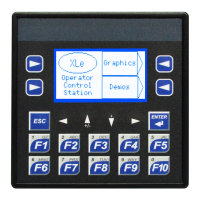MAN0878-09-EN_XLE_XLT_UserManual
A u g u s t 2 3 , 2 0 1 8 P a g e 27 | 158
5.4 RS-485 Termination
Proper RS-485 termination minimizes reflections and improves reliability.
Both serial ports allow an internal 121Ω RS-485 termination resistor to be placed across pins 1
and 2. This can be done by installing a jumper / switching the dip switch. Please refer to the
XLE/XLT data sheet for jumper / switch locations.
NOTE: Only the two devices physically located at the endpoints of the RS-485 network should
be terminated.
5.5 RS-485 Biasing
RS-485 biasing passively asserts a line-idle state when no device is actively transmitting,
which is useful for multi-drop RS-485 networking.
Both serial ports allow internal 390 Ω RS-485 bias resistors to be switched in, pulling pin 1 up
to 3.3V and pin 2 down to ground. The Set Serial Ports item in the System Menu (Chapter 9)
can be used to enable RS-485 biasing. Also, an application graphics screen that writes to
%SR164 can do the same thing. Setting %SR164.1 enables MJ1 biasing and setting %SR164.2
enables MJ2 biasing.
If biasing is used, it should be enabled in only one of the devices attached to the RS-485
network.
5.6 Cscape Programming via Serial Port
If a PC COM port is connected to the XLE/XLT MJ1 serial port, Cscape can access the XLE/XLT
for programming and monitoring.
5.7 Ladder-Controlled Serial Communication
Using Serial Communication function blocks, both MJ1 and MJ2 support Generic, Modbus
Master and Modbus Slave Protocols. In addition, external modems can be connected and
accessed using Init, Dial and Answer Modem function blocks.

